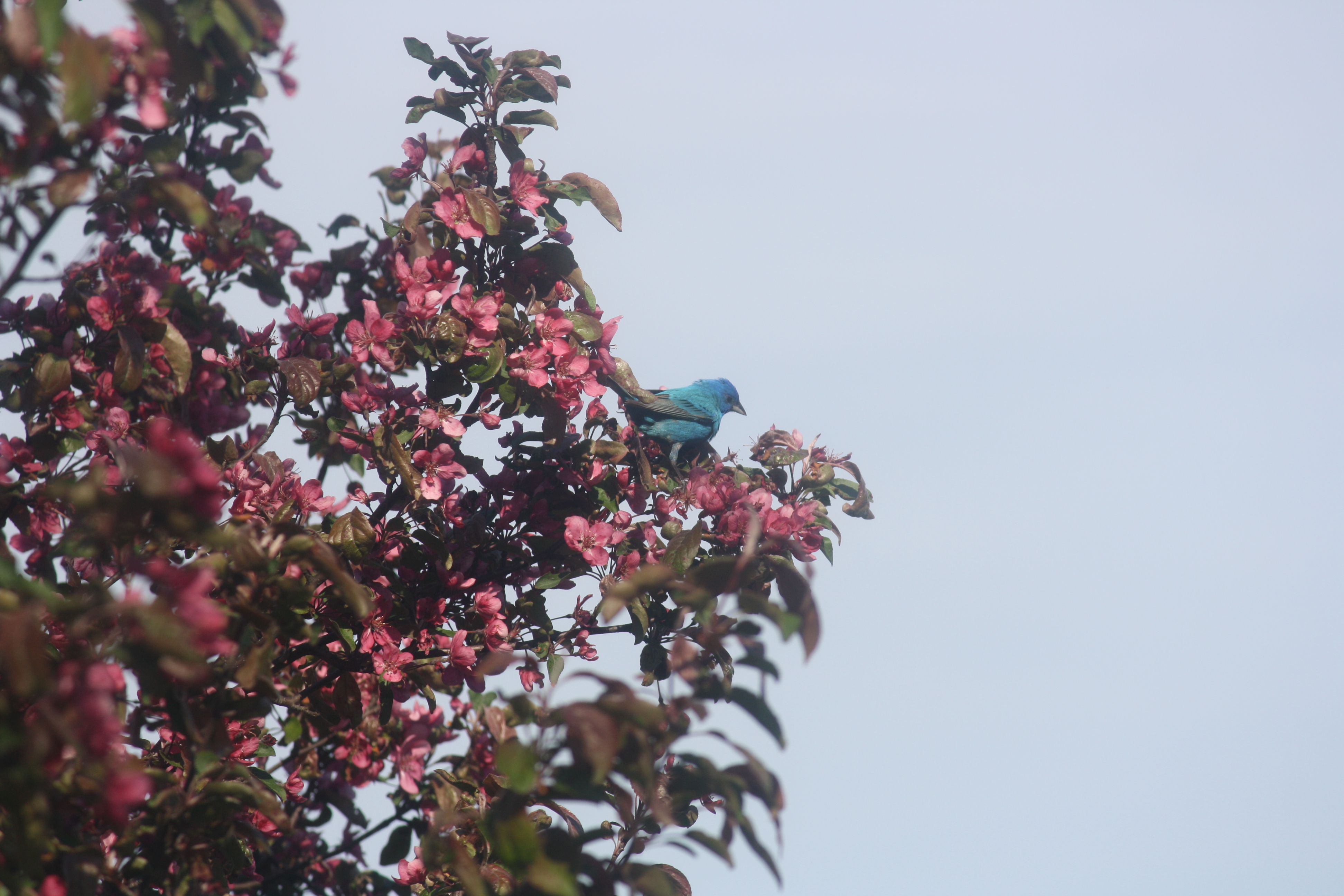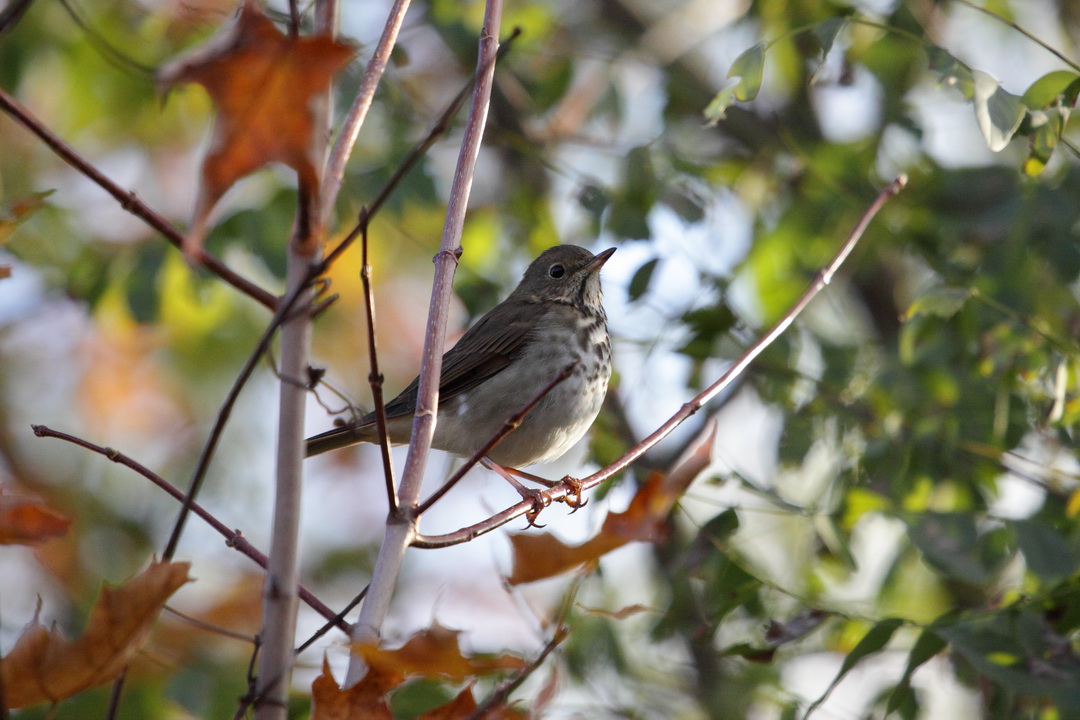5 Bird Species Returning to Mount Royal this Spring
- May 14, 2020
Mount Royal is a paradise for amateur and professional birdwatchers hoping to spy birds right here in the city. In fact, over 180 different bird types flock to the mountain throughout the seasons.
After heading south for the winter to prime destinations such as Florida, the southern United States and Central America, many bird species return north in the spring for the mating season. Here are five birds that have come home to nest in the forests of Mount Royal!

Photo : Christian Fritschi
The red-eyed vireo feeds mainly on adult insects, larvae, caterpillars and berries, and is often difficult to observe because it hunts high among the foliage in the canopy. However, its loud and persistent song during breeding period (a series of short phrases like “cherr-o-wit” repeated up to 40 times per minute) might help you spot it!
Its characteristic red eyes are due to proteins called cytochromes, which provide an important detoxifying function. The brighter the red, the healthier the bird, and the more likely it will seduce a female during the mating season. In biology, this is referred to as an “honest signal,” implying that the male has all the necessary qualities for reproduction.
Where to Observe the Red-Eyed Vireo
This type of songbird lives throughout the park, mainly in mature forest areas around the Mount Royal Summit, behind the Mount Royal Chalet. Listen carefully for its call and you might find it!

Photo : S. Montigné
During the time it spends on the mountain, the indigo bunting feeds on spiders, insects (caterpillars, tree bugs, grasshoppers), as well as berries and seeds, which it gathers as a couple or in small groups.
Male indigo buntings are easily recognizable by their beautiful blue feathers, whereas females are brownish with the odd blue accent in their wings or tail. The indigo bunting tends to perch on dead trees and its song can often be heard in open areas of the forest.
Where to Observe the Indigo Bunting
The best places to spot the indigo bunting on Mount Royal are in the open areas by the Montreal General Hospital, in the steep forested area around the main staircase and close to the Camillien-Houde Belvedere. To catch sight of one, look to the treetops and listen for its cry:

Photo : Jean-Marie Van der Maren
Like many other birds, the Cooper’s hawk heads south for the winter to the southern United States and Mexico where the climate isn’t as cold. However, it only flies south when food becomes scarce, which means that its departure date varies from one year to the next.
The Cooper's hawk preys mainly on forest birds that it catches thanks to its very agile flight skills (it will even fly at top speeds through branches to snag its prey). Its favourite snacks? A variety of birds, but also insects, reptiles, amphibians and even small squirrels!
Where to Observe the Cooper’s Hawk
Only two or three Cooper’s hawk nests have been sighted on the Mount Royal territory, which tells us that two or three couples nest on the mountain. To observe a Cooper’s hawk, you need patience and a stroke of luck. Because of the sheer size of the territory and the very few specimens encountered here, it is very rare to see one in the air, but its easily recognizable call will alert you of its presence:

Photo : Melissa McMasters
Like all strict insectivores, the eastern wood pewee only begins its migration when insects become scarce, which is usually in September.
Where to Observe the Eastern Wood Peewee
Like the red-eyed vireo, also an insectivore, the eastern wood pewee can be seen throughout the park, mainly in the canopy and in sparse woods, especially around the summit loop.
With its dull brownish plumage that blends with the colour of branches, the eastern wood pewee can be hard to detect especially since it perches high up in the canopy. However, its easily recognizable call (“Piouiii”) is a sure hint it’s close by:

Photo : Jordan Guertin Desroches
The hermit thrush generally nests on the ground or in low shrubs. This makes it very sensitive to any kind of disturbance to its habitat, especially when humans or dogs get a little too close for comfort.
Where to Observe the Hermit Thrush
In general, the hermit thrush prefers coniferous, deciduous or mixed forests. On Mount Royal, it is often spotted in the woods opposite Smith House, along with the other types of thrushes found on the mountain.
Heralding spring, the thrush’s mating call is celebrated in many poems and songs. In his book “Walden,” the poet and naturalist Henry David Thoreau also sings the praises of this type of bird:
“I long for wildness, a nature which I cannot put my foot through, woods where the wood thrush forever sings, where the hours are early morning ones, and there is dew on the grass, and the day is forever unproved, where I might have a fertile unknown for a soil about me.”
To help you to spot a thrush during your next visit to the mountain, listen for its call:
Interested in learning more about the wildlife that lives on the mountain? Visit our section dedicated to the fauna and flora of Mount Royal.
Back Red-Eyed Vireo

Photo : Christian Fritschi
The red-eyed vireo feeds mainly on adult insects, larvae, caterpillars and berries, and is often difficult to observe because it hunts high among the foliage in the canopy. However, its loud and persistent song during breeding period (a series of short phrases like “cherr-o-wit” repeated up to 40 times per minute) might help you spot it!
Its characteristic red eyes are due to proteins called cytochromes, which provide an important detoxifying function. The brighter the red, the healthier the bird, and the more likely it will seduce a female during the mating season. In biology, this is referred to as an “honest signal,” implying that the male has all the necessary qualities for reproduction.
Where to Observe the Red-Eyed Vireo
This type of songbird lives throughout the park, mainly in mature forest areas around the Mount Royal Summit, behind the Mount Royal Chalet. Listen carefully for its call and you might find it!
Indigo Bunting

Photo : S. Montigné
Male indigo buntings are easily recognizable by their beautiful blue feathers, whereas females are brownish with the odd blue accent in their wings or tail. The indigo bunting tends to perch on dead trees and its song can often be heard in open areas of the forest.
Where to Observe the Indigo Bunting
The best places to spot the indigo bunting on Mount Royal are in the open areas by the Montreal General Hospital, in the steep forested area around the main staircase and close to the Camillien-Houde Belvedere. To catch sight of one, look to the treetops and listen for its cry:
Cooper’s Hawk

Photo : Jean-Marie Van der Maren
The Cooper's hawk preys mainly on forest birds that it catches thanks to its very agile flight skills (it will even fly at top speeds through branches to snag its prey). Its favourite snacks? A variety of birds, but also insects, reptiles, amphibians and even small squirrels!
Where to Observe the Cooper’s Hawk
Only two or three Cooper’s hawk nests have been sighted on the Mount Royal territory, which tells us that two or three couples nest on the mountain. To observe a Cooper’s hawk, you need patience and a stroke of luck. Because of the sheer size of the territory and the very few specimens encountered here, it is very rare to see one in the air, but its easily recognizable call will alert you of its presence:
Eastern Wood Pewee

Photo : Melissa McMasters
Where to Observe the Eastern Wood Peewee
Like the red-eyed vireo, also an insectivore, the eastern wood pewee can be seen throughout the park, mainly in the canopy and in sparse woods, especially around the summit loop.
With its dull brownish plumage that blends with the colour of branches, the eastern wood pewee can be hard to detect especially since it perches high up in the canopy. However, its easily recognizable call (“Piouiii”) is a sure hint it’s close by:
Hermit Thrush

Photo : Jordan Guertin Desroches
Where to Observe the Hermit Thrush
In general, the hermit thrush prefers coniferous, deciduous or mixed forests. On Mount Royal, it is often spotted in the woods opposite Smith House, along with the other types of thrushes found on the mountain.
Heralding spring, the thrush’s mating call is celebrated in many poems and songs. In his book “Walden,” the poet and naturalist Henry David Thoreau also sings the praises of this type of bird:
“I long for wildness, a nature which I cannot put my foot through, woods where the wood thrush forever sings, where the hours are early morning ones, and there is dew on the grass, and the day is forever unproved, where I might have a fertile unknown for a soil about me.”
To help you to spot a thrush during your next visit to the mountain, listen for its call:
Interested in learning more about the wildlife that lives on the mountain? Visit our section dedicated to the fauna and flora of Mount Royal.
